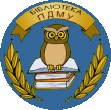 |  |

|
|

|
||||||||||||||
| ПОЛТАВСЬКИЙ ДЕРЖАВНИЙ МЕДИЧНИЙ УНІВЕРСИТЕТ | ||||||||||||||||
Бази даних |
|
Вид пошуку |
||||||||||||||
|
||||||||||||||||
електронних бібліотек і нових інформаційних технологій (Асоціація ЕБНІТ) |
||||||||||||||||